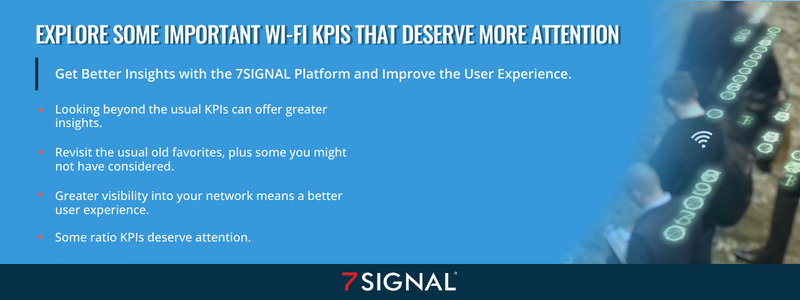
Blog
Get Better Insights with the 7SIGNAL Platform and Improve the User Experience

Consistent, reliable Wi-Fi performance is essential to business – for employees and clients, as well as mission-critical devices. Establishing wireless key performance indicators (KPIs) creates a baseline to measure efficiency and stability.
Mike Graham, sales engineer, recently led a 7SIGNAL® webinar titled Wi-Fi KPIs That Deserve More Attention. Graham reviews old favorites and some lesser-known ones.
Some old favorite KPIs
With the 7SIGNAL platform, you can test some KPIs tied to user experience.
- The attachment success rate is a relatively sensitive measure of network health directly tied to the user experience. It measures the entire authentication and association process. It’s essential for the user experience as failures and retries make connecting to the network seem slow possibly due to a roaming issue.
- Throughput – HTTP upload throughput and HTTP download throughput. These transfer a single HTTP/TCP data stream for two seconds. Unlike speed test services, they do not attempt to “max out” a connection; instead, they try to simulate a web transaction. The short test duration makes them sensitive to latency (TCP slow start). Throughput measurements aren’t relied upon heavily since the throughput required for applications is modest, and latency and packet loss are larger factors in the user experience.
- Voice (VoIP) Quality – VoIP uplink mean opinion score (MOS), VoIP downlink MOS score. A stream of short UDP packets is sent for 12 seconds, measures packet loss, jitter, and latency, and calculates a MOS score. Scores >=3.6 are considered good. This simulates voice calls. Packet loss is the real issue, while jitter and latency rarely have much of an impact.
- Passive measurements – AP retries, client retries. This KPI measures the percent of frames with the retry bit set. Values >30% are excessive and indicate some interference or very high channel utilization. Data may be sparse and unreliable in nearly idle networks. Retry rates are a valuable metric. This measurement takes the temperature of a channel; higher ”temperatures” indicate an issue, but the challenge is that retries are often the result of collisions or interference.
KPIs you might not be using
- Channel changes – AP channel: Frequent, constant channel changes may indicate interference. The controller might need a reboot or software upgrade. Use short-time averages and AP aggregation because the average channel isn’t meaningful. The visualization is useful in this case because it provides a quick, real sense of how often channel changes are occurring. For example, maybe an AP is set to channel 64 and gets DFS radar hits that push it off that channel.
- Traffic density directly measures AP load by counting the total number of frames transmitted per minute. Scaling (hourly averages): greater than 500, 000 frames per minute = sustained critical overload, greater than 200,000 frames per minute = fully loaded, around 50,000–100,000 frames per minute = comfortable load level, and less than 10,000 frames per minute = practically idle. Traffic density is a raw frame count that includes everything, whether data or a management frame. It’s a great way to measure how busy an access point is above and beyond the number of users attached to it. Traffic density is particularly useful in the context of an AP reporting high channel utilization, providing all the necessary details about what is generating all the traffic (could it be non-Wi-Fi interference?).
- The client 5GHz support ratio measures the percentage of users on a network (SSID) that are using 5GHz. Use an aggregation without a band. When using this test, you always want to run it without a band because if you look at the 2.4GHz or the 5G band, it will always be 100 for that band. You want to look across an SSID. If 2.4GHz is being considered for disabling, seeing how many are using it is helpful.
- Status codes monitor AP and client stats codes from authentication, association, re-association, and de-authentication, so it’s useful for debugging connection issues. Use “All Samples” averaging – average status codes are not meaningful. Status codes are used strictly for debugging connectivity issues and advanced troubleshooting. Some AP vendors might mention a specific status or reason code, and there’s visibility into how often that error occurs with a specific AP.
- Macro KPIs combine several single KPIs to measure their performance against a user-defined SLA value.
Connectivity – connect to the WLAN and execute active tests
Authentication – authenticate using a captive portal or using 802.1x
IP and DNS Services – track time to obtain a DHCP address and the ability to resolve DNS names
Quality – measure throughput and voice quality
- Ratios of KPIs. These ratios of KPIs involve some math and interpretation:
AP retries: client retries indicate how well the AP hears the client versus how well the client hears the AP and may show a power imbalance between the AP and the client.
Probe response ratio – How many responses to each probe request are seen in the air? There are many APs on 5G. Every probe eats up channel bandwidth, which can be an issue on large sites such as concert halls, sports venues, and airports.
The Wi-Fi KPIs offered with the 7SIGNAL platform optimize enterprise Wi-Fi and digital experiences for end-users, giving you visibility into and control over your network. The 7SIGNAL platform provides discreet, SaaS-enabled, available in two options, and supports rapid and fixed deployments.
Why not contact 7SIGNAL for help?
Want to improve network performance and enhance the user experience? Get the visibility into the KPIs you need with the 7SIGNAL platform. Founded by wireless networking pioneers, 7SIGNAL delivers enterprise Wi-Fi insights, control, and performance to the people and devices that need them most.
The 7SIGNAL platform is designed for the world's most innovative organizations, educational institutions, hospitals, and government agencies, and is currently deployed at IBM, Kaiser Permanente, Nike, and other Fortune 500 companies. 7SIGNAL continuously monitors the connectivity of an estimated 20 million global devices. Learn more at www.7signal.com.
Contact us to learn more.